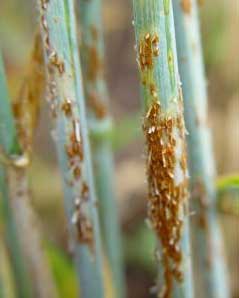El Batan, Mexico and Aleppo, Syria
January 16, 2007
|
 |
|
Ug99 infection on wheat being
screened at the Kenya Agriculture Research Institute
Njoro Research Centre.
Credit: David Mowbray, CIMMYT |
A new form of stem rust, a
virulent wheat disease, has jumped from eastern Africa and is
now infecting wheat in Yemen in the Arabian Peninsula.
Researchers with the
Global Rust Initiative
(GRI) and the Agricultural
Research Service of the United States Department of Agriculture
(USDA-ARS) have confirmed conclusively the existence of the
disease in Yemen. There is also evidence that the disease has
spread into Sudan but more tests are needed to confirm the
finding. Until this discovery, this new strain of stem rust,
known as Ug99, had only been seen in Uganda, Kenya and Ethiopia.
The last major epidemic of stem
rust occurred in North America in the early 1950s, when a strain
of stem rust destroyed as much as 40 percent of the continent's
spring wheat crop. Out of this crisis came a new form of
international cooperation among wheat scientists worldwide,
spearheaded by Nobel laureate wheat scientist Norman Borlaug.
This international alliance of scientists led to the development
of wheat varieties which resisted the onslaught of stem rust for
more than four decades. But in 1999, a new strain of stem rust
was discovered in Uganda and Kenya capable of destroying most
previously disease-resistant wheat varieties.
A year and a half ago
geographic information systems specialists working at
CIMMYT plotted the probable
trajectory of the fungus, whose spores can travel large
distances on the wind. The wind models predicted that if the
fungus crossed from eastern Africa to the Arabian Peninsula it
could easily spread to the vast wheat-growing areas of North
Africa, the Middle East, Pakistan and India.
There is precedence for this,
from a virulent strain of another wheat disease, called yellow
rust, which emerged in eastern Africa in the late 1980s. Once it
appeared in Yemen, it took just four years to reach wheat fields
of South Asia. On its way, this new strain of yellow rust caused
major wheat losses in Egypt, Syria, Turkey, Iran, Iraq,
Afghanistan, and Pakistan, exceeding USD 1 billion in value.
There is every reason to believe the new Ug99 strain of stem
rust represents a much greater risk to world wheat production.
Annual losses of as much as USD 3 billion in Africa, the Middle
East and south Asia alone are possible.
According to the
Food and Agriculture Organization
of the United Nations (FAO), countries in the predicted,
immediate pathway grow more than 65 million hectares of wheat,
accounting for 25 percent of the global wheat harvest. "If we
don't control this stem rust threat," says ME Tusneem, Chairman
of Pakistan's Agriculture Research Council, "it will have a
major impact on food security, especially since global wheat
stocks are at a historic low."
Experiments conducted over the
past two years by international researchers in the Global Rust
Initiative in Kenya and Ethiopia demonstrate clearly that most
of the world's wheat varieties are susceptible to the new Ug99
strain of stem rust. "This is a problem that goes far beyond
wheat production in developing countries," warns Borlaug. "The
rust pathogen needs no passport to cross national boundaries.
Sooner or later Ug99 will be found throughout the world,
including in North America, Europe, Australia and South
America."
GRI scientists have already
identified promising experimental wheat materials with
resistance to Ug99. But from the first breeding trials to
growing new, rust-resistant varieties in farmers' fields on
millions of hectares takes time and a massive effort.
"If we fail to contain Ug99 it
could bring calamity to tens of millions of farmers and hundreds
of millions of consumers," says Nobel Laureate Borlaug. "We know
what to do and how to do it. All we need are the financial
resources, scientific cooperation and political will to contain
this threat to world food security."
CIMMYT is an internationally
funded, not-for-profit organization that conducts research and
training related to maize and wheat throughout the developing
world. CIMMYT works to create, share, and use knowledge and
technologies to increase food security, improve the productivity
and profitability of farming systems, and sustain natural
resources.
ICARDA serves the entire developing world for the improvement of
barley, lentil, and faba bean; and dry-area developing countries
for the on-farm management of water, improvement of nutrition
and productivity of small ruminants (sheep and goats), and
rehabilitation and management of rangelands. In the Central and
West Asia and North Africa (CWANA) region, ICARDA is responsible
for the improvement of durum and bread wheats, chickpea, pasture
and forage legumes and farming systems; and for the protection
and enhancement of the natural resource base of water, land, and
biodiversity.
CIMMYT and ICARDA are research centers of the Consultative Group
on International Agricultural Research (CGIAR).
The USDA Agricultural Research Service is the United States
Department of Agriculture's chief scientific research agency.
The Global Rust Initiative aims to find solutions that can
prevent a potential wheat disaster and is a partnership of
international agricultural research centers, national research
programs and advanced research institutes. It is currently
funded by the Canadian International development Agency (CIDA),
the USDA Agricultural Research Service (USDA-ARS), the United
States Agency for International Development (USAID), and the
Indian Council for Agricultural Research (ICAR). In-kind
contributions from the Kenya Agriculture Research Institute
(KARI) and the Ethiopian Institute of Agriculture Research
(EIAR) have enabled field research with Ug99. |